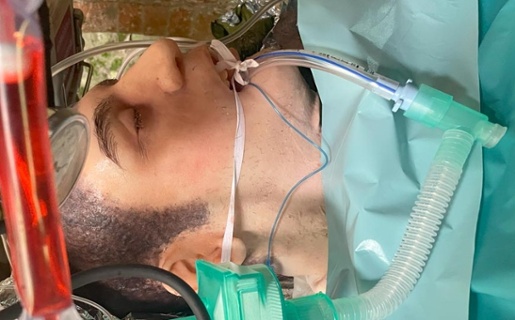Surgeon's lifelike mannequins play the victims in simulated terrorist attack

Lifelike models of casualties created by a Swansea surgeon have played a leading role in a simulated terrorist attack.
Morriston Hospital trauma consultant Professor Ian Pallister originally created realistic models of bomb blast victims, used to give military surgeons fully immersive training before they reached the front line.
Although these consisted of specific body parts such as legs and torsos, they have now developed into full-body versions which can reproduce different injuries including blast wounds and gunshots.
Developed, as with the previous models, in partnership with the Ministry of Defence, the Surgical Advanced Mannequin, or SAM, was used for the first time in an Army clinical exercise earlier this year.
It “breathes” and can be pumped with fake blood to simulate bleeding. The model can be intubated, have “dead tissue” removed and be used for exploratory surgery. Earlier versions of the SAM have been used to train Ukrainian military surgeons.
Professor Pallister created the SAM using CT scans and 3D printed masters of specific wounds, which also include pelvic injuries.
“They have progressed to the point where wherever possible we're using a whole-body model rather than just a truncated injured part,” he said.
 “This helps reinforce the immersion in the simulated situation as a whole, rather than just looking at it purely as the execution of a task.
“This helps reinforce the immersion in the simulated situation as a whole, rather than just looking at it purely as the execution of a task.
“The execution of a task is important, but we also want people to experience something of the reality of the situation.
“Obviously not the full reality. We can't or wouldn't wish to reproduce that but just to help reinforce and help people immerse in things and so on, rather than feel that sense of disconnect from performing a simple task.”
After their debut at the Army training exercise, the SAMs were put into action again this month – this time at a special event held at Cardiff’s Principality Stadium.
Professor Pallister (right) is a member of the British Trauma Society, a national organisation for health professionals involved in trauma care.
It held its Annual Scientific Meeting at the Principality Stadium over two days, which included a simulation-based training day which Professor Pallister ran, and which featured three of his SAMs.
He is also Welsh ambassador for the UK-wide citizenAID charity, set up by a group of civilian and military clinicians in 2017.
It prepares people, communities and organisations to help themselves and each other when there are multiple casualties particularly from deliberate attacks. CitizenAID was also involved in the Cardiff event.
“The day was themed around a vehicle being used as a weapon,” said Professor Pallister.
“After some introductory talks in one of the rooms in the Principality Stadium, everyone moved move out on to the concourse where we had a simulated street scene with models set out as the casualties.
“Some of the participants were given citizenAID wristbands, but they were not told why. They were effectively the good Samaritans.
“The armed police had already ‘shot’ the assailant and established that the hot zone was safe. But the good Samaritans were trapped in the hot zone, and they attended to the casualties as best they could.”
 After that, two crews from the Emergency Medical Retrieval and Transfer Service – the so-called flying doctors which travel on the Wales Air Ambulance – arrived to take over and provide a professional level of care.
After that, two crews from the Emergency Medical Retrieval and Transfer Service – the so-called flying doctors which travel on the Wales Air Ambulance – arrived to take over and provide a professional level of care.
Then the “casualties” were carried to another area, where the participants spent the rest of the day going through different skill stations.
“These were to do with how the patients would be managed, partly reviewing what would be done at the point of wounding, but more to do with what would then happen in terms of damage control, resuscitation and surgery,” said Professor Pallister.
“The goal was to broaden and deepen the participants’ understanding of the simple things which can be done to help save lives in such tragic circumstances.
“Feedback was very good, confirming the value of enriching people’s knowledge beyond the scope of their usual working lives.”
It was one of the first major events, and certainly the first in Wales, that citizenAID had participated in since the pandemic. Professor Pallister said that due to Covid it had almost fallen off the radar.
“But with circumstances being as they are, the idea of having members of the public switched on to the possibility that they might have to provide improvised care when they least expect it is probably more relevant now than it was just a few months ago,” he added.
“We need to start generating some more interest and more awareness.”
Rydym yn croesawu gohebiaeth a galwadau ffôn yn y Gymraeg neu'r Saesneg. Atebir gohebiaeth Gymraeg yn y Gymraeg, ac ni fydd hyn yn arwain at oedi. Mae’r dudalen hon ar gael yn Gymraeg drwy bwyso’r botwm ar y dde ar frig y dudalen.
We welcome correspondence and telephone calls in Welsh or English. Welsh language correspondence will be replied to in Welsh, and this will not lead to a delay. This page is available in Welsh by clicking ‘Cymraeg’ at the top right of this page.